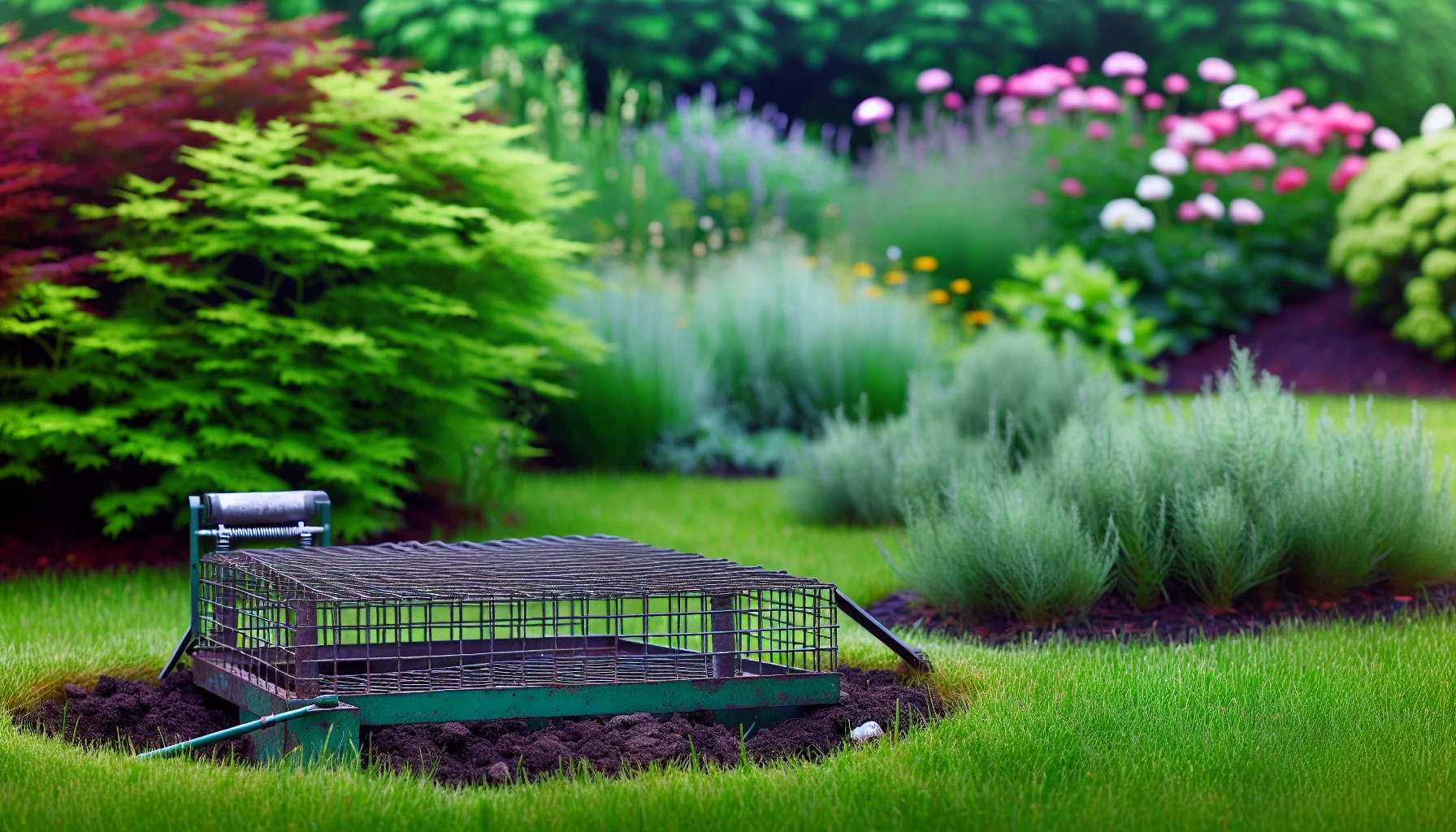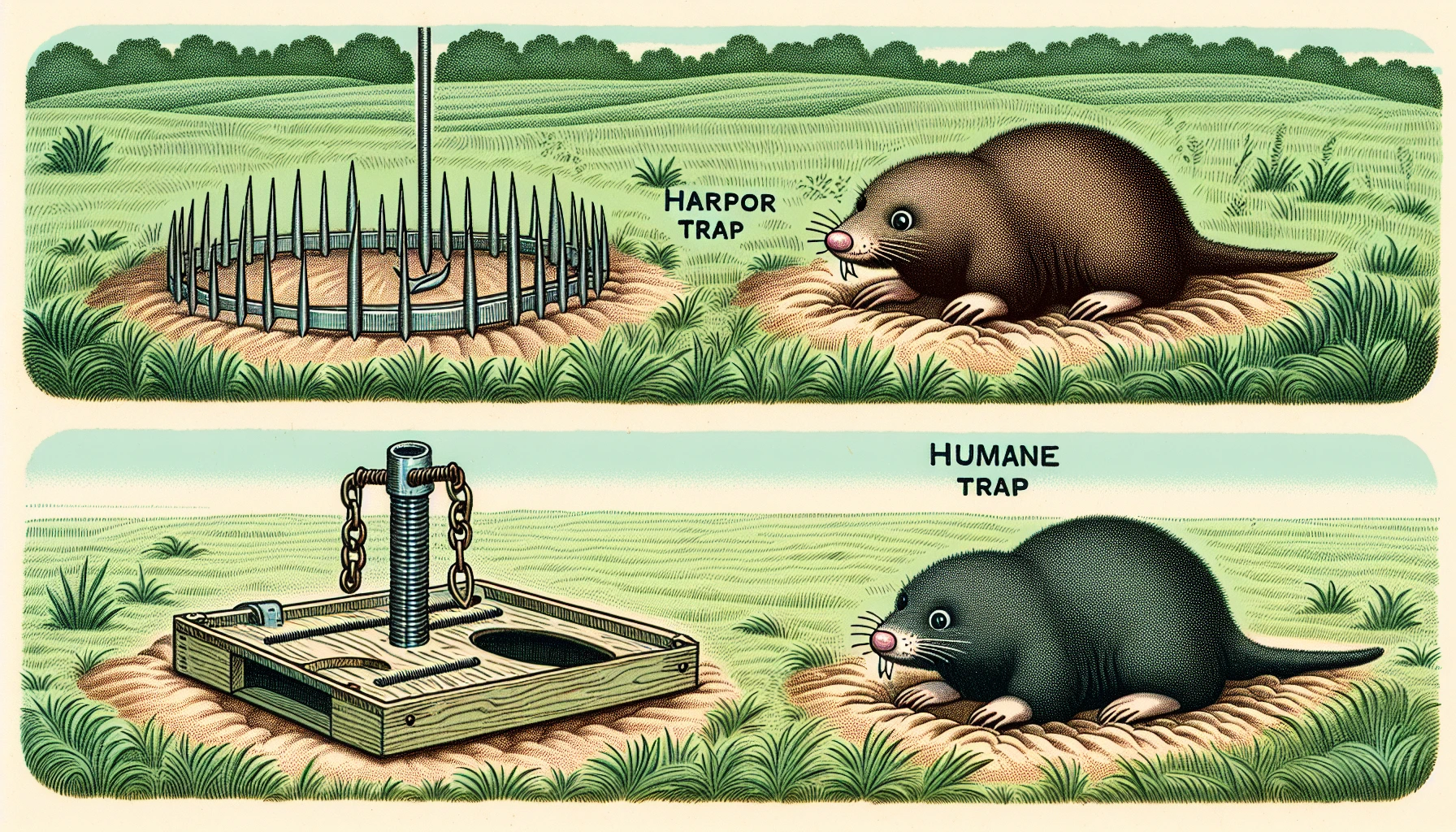Top Strategies to Eliminate Moles in Yard and Prevent Future Infestations
Are you tired of unsightly mounds and tunnels ruining your beautiful lawn or garden? Moles can wreak havoc on your yard, but don’t worry – you’re not alone, and there are proven methods to eliminate these pesky critters. This comprehensive guide will walk you through identifying moles in yard, effective control strategies, and how to maintain a mole-free yard.
Key Takeaways
- Identify moles and their damage to effectively manage them.
- Adopt preventive measures such as eliminating food sources, proper lawn care, and monitoring for mole activity to maintain a mole-free yard.
- Utilize professional methods like trapping, baiting repellents & barriers when infestations become too severe.
Identifying Moles and Their Damage in Your Yard

Suffering from mysterious mounds of dirt and raised ridges in your yard? It could be a mole infestation! These small burrowing mammals are known for their efficient digging skills, making them a nuisance for homeowners. Identifying moles and the damages they cause is the first step to effectively control and eliminate them from your property.
We will learn more about these burrowers and how to identify their presence.
Physical Features of Moles
Moles are fascinating creatures with remarkable adaptations for their underground lifestyle. They have paddle-shaped feet, sharp claws, and pointed snouts, which enable them to dig mole tunnels quickly and efficiently in search of food. Their strong front limbs and shovel-like hands are perfect for tunneling, while their streamlined bodies and velvety fur help them move through the soil with ease. Their sensitive snouts and whiskers also help them navigate and find prey in their underground environment.
There are 42 species of moles in the family Talpidae, each possessing unique physical features. They all share:
- a cylindrical body
- small eyes
- reduced or covered ears
- velvety fur
- enlarged front feet
- toenails that are specially adapted for digging.
Signs of Mole Damage
Now that you know what moles look like, how can you tell if they’re causing damage in your yard? Signs of mole damage include raised linear ridges and volcano-shaped mounds accompanied by soil pushed up from underground. Multiple lines of ridges entering and exiting your yard may indicate a severe infestation, requiring professional mole control services.
Moles can also damage lawns and gardens through tunneling, uprooted plants, and mounds of soil. Some plants, like marigolds and daffodils, are more prone to mole damage. Keep an eye out for these signs of mole activity and act promptly to address the issue.
Top Mole Control Methods

Once you’ve identified moles in your yard, it’s time to take action! There are several tried and true methods for controlling moles, including:
- Trapping
- Baiting
- Repellents
- Barriers
Combining these approaches can help you get rid of moles and prevent future infestations.
We will now examine these effective mole control methods that can help you regain control of your yard.
Trapping Moles

Trapping moles is one of the most reliable and efficient ways to eliminate them from your yard. There are several types of mole traps available, including harpoon traps, scissor-jaw traps, and the mole trap. Victor’s harpoon or plunger-style trap has become very popular among homeowners. It is a great choice for anyone looking to control their rodent problem.
Wearing gloves when setting up mole traps helps to avoid leaving human scent on the traps, which could deter moles. The best times to trap moles are spring and fall, their most active periods. Trapping them during these times will help prevent infestations and manage their population in your yard.
Baiting Techniques
Baiting techniques involve using poison baits that mimic the moles’ natural food sources, such as earthworms, to effectively kill them. Grain baits, gel baits and synthetic worm baits are three different types of mole baits. These provide options for controlling moles in any environment. Gel baits that employ the anticoagulant warfarin have been proven to be highly effective.
Remember to take safety precautions when using mole bait. Ensure pets do not access treated areas, and do not use the bait above ground. Following these guidelines will allow you to use baiting techniques safely and effectively to control mole populations in your yard.
Repellents and Natural Deterrents
Repellents and natural deterrents can also help keep moles away from your yard. Castor oil, garlic, and other natural ingredients can be used as repellents for moles. By spreading castor oil mixtures around your yard, you can create an environment that moles find unappealing.
Certain plants, such as:
- Daffodils
- Marigolds
- Alliums
- Castor bean plants
Possess pungent aromas that can act as a deterrent to moles. Planting these species around the edges of your garden may create a natural barrier that discourages moles from entering your yard.
Barriers and Exclusion
Installing barriers and exclusion methods can prevent moles from entering your yard. Physical barriers, like trenches filled with rocks or wire mesh, can be used to create a perimeter around your yard. Dig-proof barriers, which are man-made boundaries around a property that obstruct moles from burrowing inside, can also be effective.
Implementing barriers and exclusion methods will protect your yard from mole infestations and maintain a beautiful, mole-free lawn.
Maintaining a Mole-Free Yard
Once you’ve eliminated moles from your yard, it’s essential to take preventive measures to ensure they don’t return. Maintaining a mole-free yard involves eliminating food sources, proper lawn care, and monitoring for mole activity.
Following these steps will help keep your yard in pristine condition and protect it from future mole infestations.
Eliminate Food Sources

Moles are attracted to food sources like earthworms, grubs, snails, spiders, mole crickets, and other insects, which moles eat. To discourage moles from inhabiting your yard, it’s important to control grub populations. Detecting grub infestations can be done by looking for patches of dead grass that lift up easily and digging up small spots in suspicious areas to check for off-white grub worms with brown heads.
To manage grub populations, you can implement beneficial nematodes or milky spores to eradicate grubs or apply an insecticide. Controlling grub populations will discourage moles from entering your yard in search of food.
Proper Lawn Care
Proper lawn care is essential for preventing mole infestations. Regular mowing can discourage mole activity by removing their shelter and making the area less inviting. Additionally, avoid overwatering your lawn, as soft and damp soil conditions attract moles due to the ease of digging and abundant insect populations.
Maintaining a well-groomed lawn and avoiding overwatering will create an environment that is less appealing to moles, thereby reducing the likelihood of infestations.
Monitoring for Mole Activity
Regularly monitoring your yard for signs of mole activity is crucial for addressing any issues promptly. Look for:
- Fresh mounds of earth appearing overnight
- Raised and swelled areas
- Loose and damp soil between grass blades on newly formed molehills
- Squishy grass
These signs may indicate recent mole activity.
Keep an eye on your yard, particularly during the times of year when mole activity is at its highest, such as spring and fall. Monitoring for mole activity will enable you to address any problems quickly and maintain a mole-free yard.
Myths and Ineffective Mole Control Methods

While some methods are effective in controlling moles, it’s important to be aware of the myths and ineffective strategies that are often suggested. These include ultrasonic devices, home remedies, and misconceptions about natural predators and repellent plants.
Understanding the limitations of these approaches will help you avoid wasting time and resources on ineffective mole control methods.
Ultrasonic Devices
Ultrasonic devices, which emit high-frequency sounds inaudible to humans, have been claimed to deter moles from your yard. However, studies have shown that these devices are not effective in repelling moles. Relying on ultrasonic devices for mole control may lead to disappointment and continued mole problems in your yard.
Home Remedies
Home remedies for mole control, such as flooding or using mothballs, are not only ineffective but may also be harmful as mole repellents. Moles can easily dig deeper or relocate to avoid flooding, and mothballs are designed to repel moths, not moles. They can also be hazardous if inhaled.
It would be better to rely on proven mole removal methods for mole control instead of home remedies.
Misconceptions About Natural Predators and Repellent Plants
Relying on natural predators, like owls or domestic pets, or planting repellent plants, such as marigolds or daffodils, is not a reliable method for mole control. Encouraging pets to confront moles can expose them to diseases and parasites carried by these burrowers.
Proven methods like trapping, baiting, repellents, and barriers are the best options for controlling, helping to kill moles, and repel moles.
When to Hire a Professional
Sometimes, the mole infestation in your yard may be too severe or persistent for DIY methods. In such cases, hiring a professional to ensure effective and safe mole removal is recommended. Recognizing the signs of a severe infestation and selecting the right professional can save you time, money, and frustration in the long run.
Signs of Severe Infestation
Severe mole infestations can cause extensive damage to your yard. Indications of a severe infestation include:
- Mounds of dirt
- Dying or dead patches of grass or plants
- Visible tunnels on the surface
- An increase in weeds
If you notice these signs in your yard, it may be time to seek professional help for mole removal.
Addressing a severe infestation promptly will prevent further damage to your lawn and garden and restore the beauty of your outdoor space.
Choosing the Right Professional
When hiring a professional for mole removal, choosing a reputable service like Metro Wildlife Control, which offers affordable removal services in the Charleston, SC area, is essential. Here are some factors to consider when choosing a professional:
- Verify that the professional has proper certification
- Ensure that they are licensed and insured
- Look for a professional with extensive knowledge and experience in mole control
The cost of professional mole removal services can range from $150 to $1,500, depending on factors like the number of moles and location. Investing in professional mole removal will ensure effective and safe mole control, protecting your yard from further damage.
Summary
In conclusion, effective mole control involves identifying moles and their damage, implementing proven control methods like trapping, baiting, repellents, and barriers, and maintaining a mole-free yard through proper lawn care and monitoring. By following these steps and seeking professional help when needed, you can protect your yard from mole infestations and enjoy a beautiful, well-maintained outdoor space.
Frequently Asked Questions
What is the fastest way to get rid of moles in your yard?
Trapping is the most effective way to get rid of moles, and it should be done in the fall or early spring when they are active near the soil’s surface.
Why do I suddenly have moles in my yard?
Moles likely invaded your yard because of the availability of food sources like earthworms, grubs, and lawn insects. To help limit their food supply, try using products labeled to control grubs, ants, mole crickets, and other lawn insects.
Will moles eventually leave my yard?
Moles may leave the yard if there is a decrease in food sources or an increase in predators, but they will happily stay if they have a steady supply of food.
How do you deter moles in your yard?
Trapping and baiting are the most effective solutions for deterring moles in your yard, as well as eliminating their food sources, applying repellents, digging trenches and barriers, using plants to act as barriers, using ultrasonic devices, and stimulating drought conditions.
What are the main food sources for moles?
Moles feed primarily on earthworms, grubs, snails, spiders, and other insects.
